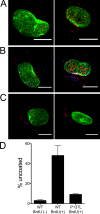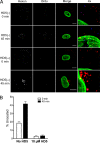Direct evidence from single-cell analysis that human {alpha}-defensins block adenovirus uncoating to neutralize infection
- PMID: 20130047
- PMCID: PMC2849482
- DOI: 10.1128/JVI.02471-09
Direct evidence from single-cell analysis that human {alpha}-defensins block adenovirus uncoating to neutralize infection
Abstract
Human alpha-defensins are evolutionarily conserved effectors of the innate immune response with broadly acting antibacterial activity. Their role in antiviral immunity is less well understood. We previously showed that these antimicrobial peptides are potent inhibitors of human adenovirus infection. Based on biochemical studies and indirect evidence from confocal microscopy, we proposed that defensins bind to and stabilize the virus capsid and neutralize infection by preventing the release of the endosomalytic protein VI. To determine whether defensin action also restricts exposure of the viral genome, we developed a system to evaluate adenovirus uncoating during cell entry by monitoring the exposure of BrdU-labeled viral genomes. This assay allowed us to determine the kinetics of uncoating of virus particles in single cells. Using this assay, we now provide direct evidence that human alpha-defensins block adenovirus infection by preventing uncoating during cell entry.
Figures





Similar articles
-
Insight into the mechanisms of adenovirus capsid disassembly from studies of defensin neutralization.PLoS Pathog. 2010 Jun 24;6(6):e1000959. doi: 10.1371/journal.ppat.1000959. PLoS Pathog. 2010. PMID: 20585634 Free PMC article.
-
Studies on the Interaction of Tumor-Derived HD5 Alpha Defensins with Adenoviruses and Implications for Oncolytic Adenovirus Therapy.J Virol. 2017 Feb 28;91(6):e02030-16. doi: 10.1128/JVI.02030-16. Print 2017 Mar 15. J Virol. 2017. PMID: 28077642 Free PMC article.
-
Defensins Potentiate a Neutralizing Antibody Response to Enteric Viral Infection.PLoS Pathog. 2016 Mar 2;12(3):e1005474. doi: 10.1371/journal.ppat.1005474. eCollection 2016 Mar. PLoS Pathog. 2016. PMID: 26933888 Free PMC article.
-
Insights into Adenovirus Uncoating from Interactions with Integrins and Mediators of Host Immunity.Viruses. 2016 Dec 21;8(12):337. doi: 10.3390/v8120337. Viruses. 2016. PMID: 28009821 Free PMC article. Review.
-
Defensins in Viral Infection and Pathogenesis.Annu Rev Virol. 2017 Sep 29;4(1):369-391. doi: 10.1146/annurev-virology-101416-041734. Epub 2017 Jul 17. Annu Rev Virol. 2017. PMID: 28715972 Review.
Cited by
-
Fowl adenovirus serotype 4 enters leghorn male hepatocellular cells via the clathrin-mediated endocytosis pathway.Vet Res. 2023 Mar 14;54(1):24. doi: 10.1186/s13567-023-01155-z. Vet Res. 2023. PMID: 36918926 Free PMC article.
-
Salmonella enterica Infection of Murine and Human Enteroid-Derived Monolayers Elicits Differential Activation of Epithelium-Intrinsic Inflammasomes.Infect Immun. 2020 Jun 22;88(7):e00017-20. doi: 10.1128/IAI.00017-20. Print 2020 Jun 22. Infect Immun. 2020. PMID: 32284374 Free PMC article.
-
Emerging antiviral therapeutics for human adenovirus infection: Recent developments and novel strategies.Antiviral Res. 2021 Apr;188:105034. doi: 10.1016/j.antiviral.2021.105034. Epub 2021 Feb 10. Antiviral Res. 2021. PMID: 33577808 Free PMC article. Review.
-
Functional genetic and biophysical analyses of membrane disruption by human adenovirus.J Virol. 2011 Mar;85(6):2631-41. doi: 10.1128/JVI.02321-10. Epub 2011 Jan 5. J Virol. 2011. PMID: 21209115 Free PMC article.
-
Human coronaviruses: activation and antagonism of innate immune responses.Microbiol Mol Biol Rev. 2025 Mar 27;89(1):e0001623. doi: 10.1128/mmbr.00016-23. Epub 2024 Dec 19. Microbiol Mol Biol Rev. 2025. PMID: 39699237 Review.
References
-
- Arnberg, N. 2009. Adenovirus receptors: implications for tropism, treatment and targeting. Rev. Med. Virol. 19:165-178. - PubMed
-
- Cerullo, V., M. P. Seiler, V. Mane, N. Brunetti-Pierri, C. Clarke, T. K. Bertin, J. R. Rodgers, and B. Lee. 2007. Toll-like receptor 9 triggers an innate immune response to helper-dependent adenoviral vectors. Mol. Ther. 15:378-385. - PubMed
Publication types
MeSH terms
Substances
Grants and funding
LinkOut - more resources
Full Text Sources

